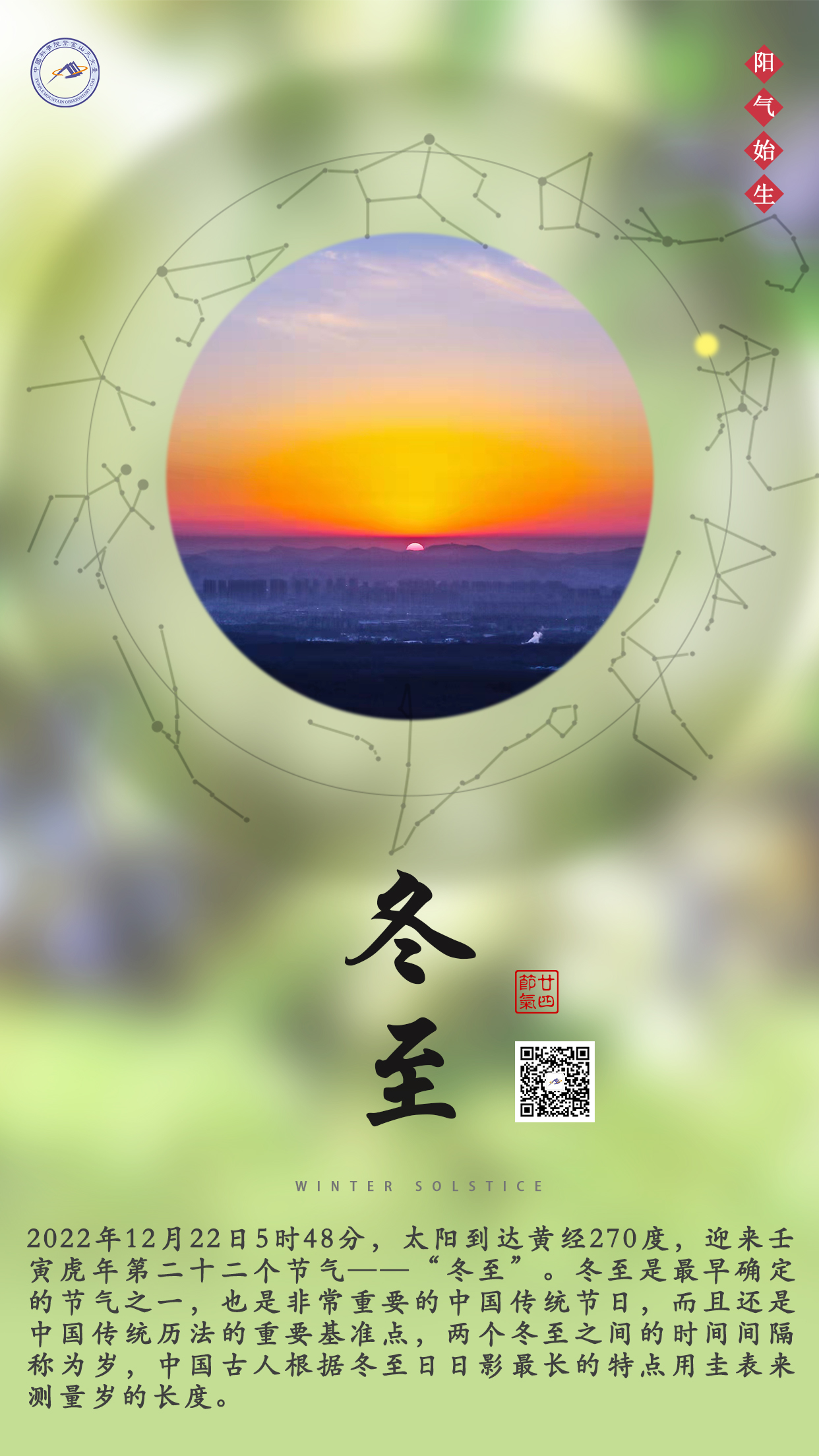“冬至日光白,始知陰氣凝。”《中國天文年歷》顯示,北京時間12月22日5時48分迎來2022年“冬至”節氣。

天象預報
**冬至——**小寒
太陽
在人馬座運行。目前太陽活動性有所增強,太陽正面有數群黑子,可通過帶減光的望遠鏡觀測。1月5日0時17分,地球過軌道近日點,距離太陽0.983天文單位,太陽的視直徑達到一年中最大值,為32′32″。
月亮
2023年1月4日凌晨3時37分,火星合月,地心所見火星在月球以北0.54度。3日晚,我國可見二者相伴出現在東方夜空,非洲、印度洋等地可見月掩火星。
水星
在人馬座運行,12月29日,水星留,之后由順行轉為逆行。日落后可向西南方低空用望遠鏡嘗試觀測。
金星
從人馬座順行至摩羯座。12月29日,水星合金星,二者相距約1.4度,日落后可向西南方低空用望遠鏡嘗試觀測。
火星
在金牛座逆行。12月26日火星上迎來春分,太陽直射火星赤道,這一天也是火星的新年。日落后,明亮的火星高懸東方,整夜可見。目前仍是一年中觀測條件最好的時期。
木星
在雙魚座順行。12月22日木星東方照,位于太陽以東90度的位置,入夜后明亮的木星位于南方天空,前半夜可以觀測。
土星
在摩羯座順行。入夜后位于西南方天空,晚上9時左右落下。
流星雨
北京時間2023年1月4日11時,北半球三大流星雨之一的象限儀座流星進入極大,預計最大天頂每時出現率(ZHR)為110。輻射點在后半夜升起,但觀測會受到月光的強烈影響。
小知識
“一九、二九不出手;三九、四九冰上走;五九、六九,沿河看柳;七九河開,八九雁來;九九加一九,耕牛遍地走。”這是在我國民間廣為流傳的數九歌。所謂數九即從冬至日算起,每9天為一個“九”,第一個9天為“一九”,第二個9天為“二九”,依此類推,第九個9天為“九九”,共計81天。冬至日是寒冬來臨的標志,九九結束則在驚蟄和春分之間,此時已是春回大地。
民間流傳的若干版本的數九歌都是在長期的生產和生活實踐中總結出來的,形象生動地反映了寒冬到來至來年春季回暖期間的氣候和物候變化過程。
冬至還是我國傳統文化中非常重要的祭祀節日,有著“冬至大如年”的說法。自古就有冬至祭天祭祖的活動:帝王于郊外舉行祭天大典,為天下蒼生祈求風調雨順、國泰民安;民間百姓則祭拜祖先,表達緬懷先人、不忘根本之情。
The Winter Solstice
The twenty-second solar term of 2022 , Winter Solstice (Dongzhi in Chinese), falls on December 22nd at 5:48, when the longitude of the Sun reaches 270o. As one of the earliest established solar terms, Winter Solstice is also an important traditional Chinese festivity and base point in traditional Chinese calendar. The period between two successive winter solstices is called “sui” (meaning one year in Chinese). According to the regularity that the sun casts the longest shadow on Winter Solstice, ancient Chinese measures the length of a year with a gnomon.
Astronomical Forecast
Winter Solstice——Minor Cold
⊙
The Sun
?
The sun travels in Sagittarius. Currently, solar activities are increasing, with a few groups of sunspots on its surface. They can be observed through a telescope with a solar filter. On January 5th, 00:17, the earth is at perihelion, with earth-sun distance being 0.983 AU. The apparent diameter of the sun is 32'32'', the largest of the year.
?
The Moon
?
On January 4th, 03:37, Mars is at conjunction with the moon. Seen from the centre of the earth, Mars is at 0.54 o north to the moon. On the evening of January 3rd, Mars and moon will appear together in the eastern sky in China,while in Africa and Indian Ocean , lunar occultation of Mars can be observed.
?
Mercury
?
Mercury travels in Sagittarius. On December 29th, Mercury is stationary, after which it changes from prograde motion to retrograde motion. Mercury might be found after sunset in low south-eastern sky with a telescope.
♀
Venus
?
Venus arrives Capricornus in prograde motion . On December 29th, it is at conjunction with Mercury, with a distance of 1.4o. After sunset, they might be found in the low sky through a telescope pointing south-west.
♂
Mars
?
Mars travels in Taurus in retrograde motion. December 26th is the vernal equinox on Mars, when the sun shines directly above Mars' equator, which marks the new year's day of Mars. After sunset, Mars hangs high in the eastern sky , observable all night long. It is now the best time of the year to observe Mars.
?
Jupiter
?
Jupiter travels in prograde motion in Pisces. On December 22nd, the planet is at eastern quadrature. In the evening, a bright Jupiter appears in the southern sky and can be observed during the first half of the night.
?
Saturn
?
Saturn travels in prograde motion in Capricornus. It appears in the southwestern sky at nightfall and sets at 9 p.m.
Meteor Shower
?
On January 4th ,11 a.m. one of the three major meteor showers in the northern hemisphere, the Quadrantids enters its active period. The estimated peak Zenithal Hourly Rate (ZHR) is 110. The radiant will rise after midnight; however, observation of the meteor shower will be severely affected by moon light.
輪值主編:張水乃
制作、編輯:王科超
英文版設計:朱曼清
(金陵中學)ZHU manqing


 科普中國公眾號
科普中國公眾號
 科普中國微博
科普中國微博

 幫助
幫助
 紫金山天文臺
紫金山天文臺 